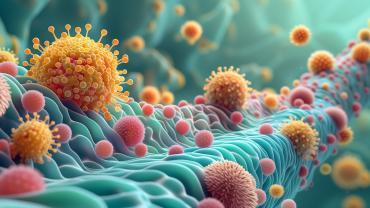
What is Anaerostipes caccae?
Originally isolated in 2002, Anaerostipes caccae (A. caccae) is a next-generation, beneficial gut microbe that may play an important role in gastrointestinal (GI) and digestive health. This spore-forming bacterium thrives in the colon's anaerobic environment and supports epithelial hypoxia, which is essential for maintaining a healthy gut microbial environment. Its ability to form spores makes it resilient enough to survive the harsh journey through the GI tract, facilitating the transit of the probiotic to the lower intestines.
A. caccae is part of the Bacillota (formerly Firmicutes) phylum, and it is capable of fermenting carbohydrates, acetate, and lactate to produce the short-chain fatty acid (SCFA) butyrate, which is vital for gut barrier integrity and healthy immune and inflammatory responses. Within the Bacillota phylum, it belongs to the Clostridium coccoides group (also known as Clostridium cluster XIVa) which is known for supporting butyrate production, gut health, and host immune health.
What role does Anaerostipes caccae play in butyrate production?
Butyrate is a key SCFA that plays an integral role in gut health. It supports colon and mucosal health by nourishing colonocytes and promoting gut barrier integrity and healthy inflammatory responses. Colonocytes absorb butyrate and oxidize it in their mitochondria, producing CO₂ and ATP, which accounts for up to 80% of their energy supply, fueling essential functions like electrolyte transport and intestinal barrier support. Butyrate also promotes the integrity of the intestinal epithelial barrier by supporting tight junctions and the mucus layer. This important SCFA may also play a role in promoting GI regularity by enhancing colonic motility and maintaining gut homeostasis.
A. caccae is metabolically flexible and capable of both primary carbohydrate fermentation and secondary cross-feeding to promote butyrate production in the lower GI tract. It can directly ferment various dietary carbohydrates, including glucose, fructose, sucrose, and prebiotic fibers, to deliver butyrate using the glycolytic and acetyl-Coenzyme A (CoA) pathways. A recent review study examined the role of butyrate-producing gut commensals from the Clostridium cluster, including A. caccae, and proposed that in the human gut, microbial butyrate is primarily synthesized from carbohydrate metabolism via the butyryl-CoA: acetate CoA-transferase pathway. In a preclinical experimental murine study, A. caccae was described as a saccharolytic (capable of metabolizing sugars to produce energy) bacterium, shown to ferment glucose, fructose, sucrose, and fructooligosaccharides to produce SCFAs under anaerobic conditions. Similarly, an in vitro experimental study found that A. caccae can metabolize fructose to produce butyrate. In addition, another in vitro experimental study found that A. caccae can ferment mucin-derived sugars such as glucose, mannose, galactose, and N-acetylgalactosamine, made by the mucin-degrading bacteria Akkermansia muciniphila (A. muciniphila) to produce butyrate, acetate, and lactate.
As an alternative butyrate synthesis method, A. caccae may promote butyrate production through a cooperative metabolic process known as cross-feeding. It can cross-feed on the lactate and acetate produced by other bacteria, such as A. muciniphila and carbohydrate-fermenting bacteria like Bifidobacterium and Lactobacillus species. For example, in an experimental preclinical murine study, A. caccae was found to produce butyrate by utilizing fermentation products, primarily lactate and acetate, generated by other commensal bacteria such as Bifidobacterium and Lactobacillus. A recent review study discussed the cross-feeding relationship between butyrogenic species, like Anaerostipes, and other commensals, like Bifidobacteria, which produce lactate and acetate. Interestingly, A. caccae has been shown to convert both the l-lactate produced by Bifidobacterium species and the d-lactate produced by Lactobacillus species, potentially playing an important role in mitigating lactate buildup and supporting a balanced microbial ecosystem. This cross-feeding conversion utilizes the acetyl-CoA pathway in which lactate is first oxidized to pyruvate and then converted to acetyl-CoA, which directly contributes to butyrate synthesis or interconverts with exogenous acetate to produce butyrate.
Several other experimental animal studies have demonstrated that administration of A. caccae may increase luminal butyrate concentrations:
Clinical research in the form of randomized controlled human trials is needed to further understand and quantify the role Anaerostipes plays in butyrate production. However, current preclinical evidence suggests that A. caccae may be an important next-generation probiotic that warrants our attention, as it may help promote microbiome diversity, GI barrier integrity, healthy immune and inflammatory responses, and digestive health, powered by butyrate production.
Learn more about Anaerostipes, SCFAs, and the GI microbiome:
Two Next-Generation Probiotics You Should Know About: Anaerostipes and Akkermansia
The Microbiome-Allergy Connection: Probiotics in Clinical Practice
The 5R Blueprint for Gut Health
Can Short-Chain Fatty Acids Elevate Your Exercise Routine?
By Antonia Toupet, PhD